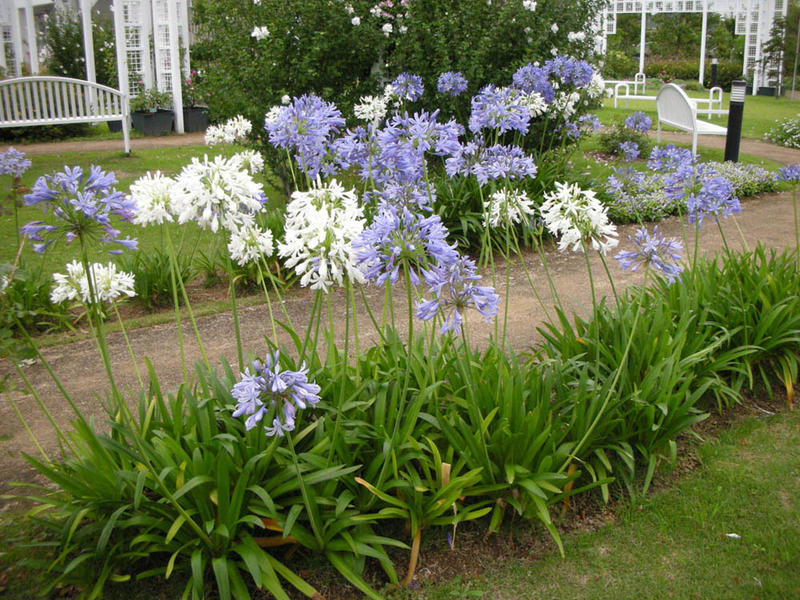Growing Agapanthus: A Total Guide to Beautiful Blooms
Growing Agapanthus: A Total Guide to Beautiful Blooms
Blog Article
Releasing the Secret to Effective Agapanthus Growing: Advice for a Flourishing Yard
In the world of horticulture, growing agapanthus effectively needs a critical technique that includes various elements of plant care. By understanding the nuances of agapanthus cultivation, one can develop an atmosphere where these plants thrive and grow abundantly.
Planting Agapanthus: Ideal Practices
When growing Agapanthus, correct dirt prep work is important for making sure effective development and growth of these beautiful flowers. Agapanthus, typically understood as Lily of the Nile or African lily, prospers in well-draining dirt with a somewhat acidic to neutral pH degree - Agapanthus. Prior to growing, it is critical to modify hefty clay soils with natural issue such as compost or peat moss to boost drainage and supply important nutrients for the plants
To grow Agapanthus, select a place that gets complete sunlight to partial color, as this will promote healthy growth and bountiful flowering. Dig a hole twice the diameter of the plant's root ball and place the Agapanthus at the very same deepness it was formerly growing. Carefully backfill the opening with soil, pushing down firmly to remove any air pockets around the origins.
Water the freshly grown Agapanthus completely and continue to keep the dirt equally wet, specifically throughout the plant's active growing period. Agapanthus. Using a balanced fertilizer once a month can better sustain the plant's growth and flowering. By following these finest practices for planting Agapanthus, you can create a stunning display screen of these fascinating flowers in your yard
Suitable Soil Issues for Agapanthus
For optimal development and blooming success of Agapanthus plants, making sure the soil conditions are ideal is vital. Agapanthus prefers dirt that is abundant in nutrients, so integrating a balanced fertilizer throughout the growing season can advertise healthy growth and vivid flowers.

Watering and Feeding Tips
To ensure healthy growth and vibrant blooms, proper watering and fertilizing techniques are important for successful Agapanthus growing. Agapanthus plants take advantage of routine watering, particularly during the expanding season. It is advised to water deeply when a week, making sure the dirt is damp however not waterlogged. During heat or in pots, even more constant watering might be needed to stop the dirt from visit their website drying out totally.
When it involves feeding Agapanthus, a balanced fertilizer with equivalent parts nitrogen, phosphorus, and potassium can be applied in the spring to promote healthy and balanced development and flowering. Slow-release plant foods are suitable for supplying nutrients gradually over an extensive duration. Avoid over-fertilizing, as this can lead to too much foliage development at the cost of blooms.
In addition, integrating raw material like compost into the dirt can enhance nutrient degrees and enhance dirt structure, aiding in the general health of the Agapanthus plants. By adhering to these watering and fertilizing tips, garden enthusiasts can ensure their Agapanthus plants prosper and produce magnificent screens of blossoms.
Pruning and Deadheading Methods
Appropriate pruning and deadheading methods play an essential duty in maintaining the wellness and aesthetic appeals of Agapanthus link plants, enhancing the vital practices of watering and fertilizing for successful cultivation. Pruning Agapanthus involves eliminating invested flower heads, dead or yellowing leaves, and general shaping of the plant to advertise much better development. Deadheading, the process of eliminating discolored flowers, not only boosts the plant's appearance however additionally encourages additional growing.
When deadheading Agapanthus, it is recommended to trim off the blossom stem at the base using sharp, tidy shears. This procedure reroutes the plant's energy from seed production back right into origin and foliage growth, advertising a much healthier and more robust plant. Normal deadheading can expand the blooming period of Agapanthus and stop self-seeding, which can bring about overcrowding.
In terms of pruning, Agapanthus normally gain from a light trim after flowering to clean up the plant and motivate fresh development. Reducing back the invested blossom stems and removing any dead or broken foliage assists preserve the plant's vitality and total look. However, it is vital to prevent reducing right into the crown of the plant, as this can deteriorate its wellness.

Protecting Agapanthus From Pests and Diseases
Applying reliable insect and disease monitoring methods is important to protecting the wellness and vigor of Agapanthus plants in cultivation. One usual bug that my latest blog post affects Agapanthus is the Agapanthus borer, a caterpillar that passages into the plant, causing damages to the flowers and fallen leaves.
In addition to insects, Agapanthus are prone to diseases such as root rot and fungal leaf areas. By remaining watchful and attending to parasite and condition issues quickly, garden enthusiasts can aid their Agapanthus grow and prosper.

Verdict
In conclusion, successful cultivation of agapanthus requires proper planting techniques, perfect soil conditions, adequate watering and fertilizing, regular pruning and deadheading, and defense from conditions and parasites. By following these suggestions and tricks, gardeners can guarantee a growing yard loaded with gorgeous agapanthus blooms. Agapanthus. Bear in mind to keep regular treatment and attention to detail to promote the health and wellness and long life of these magnificent plants
When growing Agapanthus, appropriate soil preparation is essential for making certain effective growth and development of these beautiful blossoms.Water the recently planted Agapanthus extensively and proceed to keep the soil equally damp, especially throughout the plant's energetic growing period.For ideal growth and growing success of Agapanthus plants, making sure the soil problems are suitable is important. When planting or hair transplanting Agapanthus, make sure the soil is well-prepared to give the needed foundation for the plants to develop themselves successfully. One usual bug that affects Agapanthus is the Agapanthus borer, a caterpillar that passages into the plant, creating damage to the blossoms and leaves.
Report this page